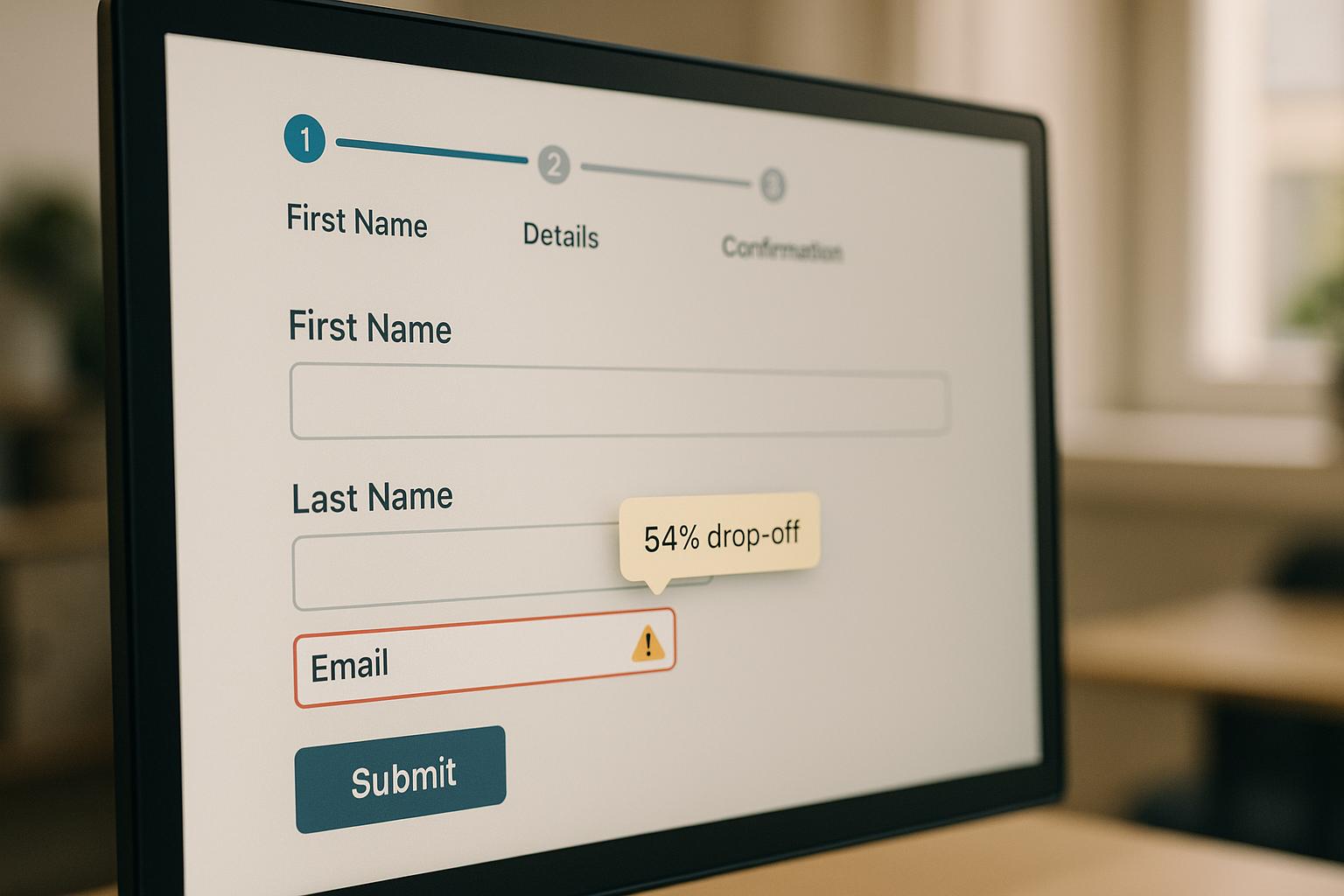Rule-based lead scoring helps B2B companies focus on the best leads by assigning scores based on actions like downloading content, visiting key pages, or attending webinars. It improves sales efficiency, shortens cycles, and boosts conversion rates by aligning marketing and sales efforts with lead quality.
Key Takeaways:
- What It Is: Assign points to leads based on demographics, firmographics, and behaviors (e.g., job title, company size, or website visits).
- Benefits: Prioritize high-value leads, save time, and improve outcomes.
- Steps to Build:
- Define scoring criteria (e.g., job role, engagement).
- Assign point values based on importance.
- Automate updates with CRM and marketing tools.
- Best Practices: Keep rules simple, clean your data, and regularly update scoring thresholds.
Start small, focus on meaningful actions, and refine your system over time to ensure it delivers results.
B2B Lead Scoring & Qualifying Process Ultimate Guide
Creating a Rule-Based Scoring System
To build a rule-based scoring system that accurately reflects buyer intent in your B2B funnel, you need a clear plan and well-defined criteria. Here's how to get started.
Choose Lead Scoring Criteria
Identify data points that indicate buying intent. These can be grouped into three main categories:
-
Demographic Scoring
Includes factors like:- Job title and seniority level
- Department and role
- Budget authority
- Industry vertical
-
Firmographic Data
Focuses on company-specific attributes:- Company size (e.g., number of employees)
- Annual revenue
- Geographic location
- Technology stack
-
Behavioral Signals
Tracks actions that show interest, such as:- Website engagement depth
- Content downloads
- Email interaction rates
- Form submissions
- Product page visits
Once you've selected your criteria, assign point values to measure their importance.
Set Point Values and Score Limits
Not all actions are equal. Assign lower points to basic activities like signing up for a newsletter or visiting a blog. More meaningful actions, such as attending a webinar or requesting a demo, should receive higher scores. Define score ranges to categorize lead quality, and fine-tune thresholds using historical conversion data. These values should align with each stage of the funnel.
Define Rules Per Funnel Stage
Tailor scoring rules to match the buyer's journey. For example:
- Awareness Stage: Assign modest points for actions like reading blog posts or following your social media.
- Consideration Stage: Increase points for deeper engagement, such as downloading case studies or visiting comparison pages.
- Decision Stage: Award the highest points for clear intent signals, like visiting pricing pages or requesting a demo.
To keep scores relevant, apply a score decay for inactivity and update your criteria regularly to reflect changing buyer behaviors. This ensures your scoring system stays aligned with your goals and customer journey.
Tools and Automation Setup
Once your scoring rules are ready, the next step is to automate updates and ensure smooth data flow.
Effective lead scoring relies on solid tech integration to keep your B2B funnel updated in real time.
Connect CRM and Marketing Tools
Integrate your CRM, marketing automation platform, and analytics tools to streamline operations:
- Marketing Automation Platform: Manage email campaigns, landing pages, and track website activity.
- CRM System: Store contact details and oversee sales interactions.
- Analytics Tools: Monitor user behavior and engagement metrics.
Make sure your tools can:
- Sync contact records automatically.
- Share behavioral data across systems.
- Update lead scores instantly.
- Trigger workflows when scores change.
Set Up Score Updates
Behavioral Score Updates
- Website visits: Adjust scores within 24 hours.
- Form submissions: Update scores immediately.
- Email interactions: Modify scores within 1 hour.
- Content downloads: Score updates in real time.
Profile Score Updates
- Job title changes: Review weekly.
- Company data updates: Validate monthly.
- Industry changes: Check quarterly.
Set up notifications for key score milestones:
| Score Threshold | Action Trigger | Response Time |
|---|---|---|
| 50 points | Email notification to SDR | 24 hours |
| 75 points | Task created in CRM | 12 hours |
| 100 points | High-priority sales alert | 4 hours |
To maintain accuracy, include these safeguards:
- Limit daily score increases.
- Add cooling periods between updates.
- Set alerts for unusual scoring activity.
- Perform monthly audits of scoring systems.
For additional support, the Marketing Funnels Directory provides a variety of automation tools tailored for B2B lead scoring. These resources simplify setup and ensure seamless integration between marketing and sales platforms.
sbb-itb-a84ebc4
Improve Your Scoring System
Once your rule-based system is set up, keeping it effective requires regular updates to match your business goals and changes in market behavior. Regularly evaluating and tweaking your lead scoring ensures it continues to deliver results.
Measure System Performance
Start by analyzing key metrics like conversion rates, deal sizes, and time-to-close for each scoring tier. Look at how scores are distributed across your leads - are there clusters or gaps that suggest your scoring is too strict or too lenient? Also, monitor how quickly leads move through your pipeline to spot inefficiencies. These insights will help you fine-tune your scoring criteria.
Update Scoring Rules
To keep your scoring system in sync with your business needs, establish a routine for updates. For example:
- Perform weekly technical checks to ensure everything is running smoothly.
- Review scores and conversion trends monthly.
- Conduct a deeper evaluation of the overall system every quarter.
Adjust your rules if you notice conversion rates dropping or if many high-quality leads are scoring below your target thresholds.
Here’s a simple process to guide your updates:
- Data Collection: Gather metrics like lead-to-opportunity rates, average sales cycle lengths, and revenue by scoring tiers.
- Analysis: Look for patterns, such as high scores that don’t convert, to identify areas for improvement.
- Implementation: Test adjustments with a small group of leads before rolling out changes across your entire system.
Common Problems and Solutions
Every scoring system, no matter how well-designed, needs regular checks to stay aligned with your funnel goals. Even the best systems can face challenges that impact their effectiveness.
Keep Scoring Simple
Complex scoring rules can lead to confusion and make maintenance harder. Focus on criteria that truly matter. Start small - stick to 5-7 key scoring rules - and expand only when necessary.
Here’s an example of a straightforward scoring framework:
| Behavior/Attribute | Point Value |
|---|---|
| Website Visit (Product Pages) | +5 |
| Downloaded Whitepaper | +10 |
| Company Size >500 | +15 |
| Job Title (Decision Maker) | +20 |
| Email Open Rate >25% | +10 |
Clean Data Management
Bad data can throw off your scoring system. To avoid this, conduct monthly data audits, enforce consistent input formats, and use trusted third-party tools to enrich your data. These steps make automation smoother and help you identify where manual reviews are most effective.
Manual vs Automated Scoring
Balancing automation with manual review is key to an effective scoring system. Use automation for straightforward digital interactions and reserve manual reviews for more complex buying signals.
Automated Scoring:
- Website visits and email engagement
- Form submissions
- Content downloads
- Basic demographic matches
Manual Review:
- Subtle or complex buying signals
- Custom deal requirements
- Industry-specific needs
- Evaluating strategic accounts
Conclusion
Summary
Rule-based lead scoring helps strengthen B2B funnels by providing a clear framework for qualifying leads. Start with essential scoring criteria, set specific point thresholds, and refine your rules based on performance. Regular updates ensure your system stays effective in identifying and nurturing the right leads.
A strong scoring system should match your sales cycle and buyer journey, rely on consistent data collection, and strike a balance between automated and manual scoring. Keeping the process straightforward while adapting to market changes helps maintain accuracy and long-term results.
For tools and expert advice, check out the resources below.
Additional Resources
The Marketing Funnels Directory offers tools and guides to improve your lead scoring system, including:
- Lead Scoring Templates: Ready-to-use frameworks designed for various B2B industries
- Integration Guides: Step-by-step help for syncing your CRM with top marketing automation platforms
- Best Practices Library: A collection of proven strategies and case studies
- Expert Consultation: Access to certified strategists for tailored system design
Explore these resources in the B2B section of the Marketing Funnels Directory (https://topmarketingfunnels.com) and start building a more effective lead scoring system today.


